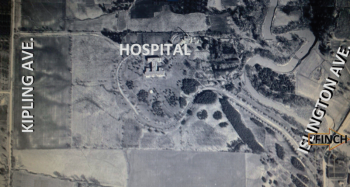
By Tim Lambrinos
Love at the wilderness hospital for sick children
The natural beauty of the Humber River Valley endures today, and is a great source of identity and pride for area residents. The surrounding farmlands to the east may have been devoured by industrialization, but the valley continues to sustain everyone, like a therapeutic natural oasis. It is a recreational wonderland and an indelible part of Emery’s existence. And to a Canadian Institution and two young lovers, it has had a magical appeal that will never be forgotten. 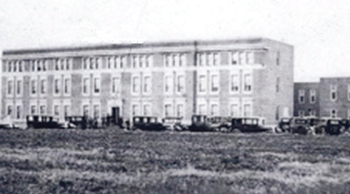
The last farms of Emery transformed into the industrial park of today approximately 60 years ago. But the first wave of industrialization around Emery occurred 30 years previous to that with the building of a unique hospital on the west bank of the Humber River in nearby Thistletown.
In 1925, the provincial government (through The Hospital for Sick Children) had a vision to create a long-term care facility for children suffering from tuberculosis (and later polio) and those recovering from surgery. The clean, fresh air, picturesque river valley and long sunny days at the height of land were considered the perfect tonic for recovery. Not surprisingly, this bucolic setting and the caring environment of the hospital were to be the perfect elements for love as well. 
The love story of young farmer Lorne Lawder and nurse Millie Ferguson is a heart-warming tale that merges the rural history of Emery with the impending urbanization.
Lawder’s great grandparents, James Lawder and Mary (Ellis) Lawder had arrived in Emery from Ireland in the early 1860s and bought a 100 acre farm on the south-west corner of Steeles and Weston Road.
They established a mixed farming enterprise that specialized in Holstein dairy cows they would milk by hand. In 1861, they welcomed a son into the world, Robert John Lawder. Robert would marry Mary Watson, from a nearby farm, and they too had a son, Ellerton Lawder who was born in 1891.
Ellerton, carrying on the family farming tradition, took Ella May Maynard as his wife in 1914. They raised a family that would include Stanley (1915), Vera (1918), Charles (1930) and, after a seven year hiatus of having no children, baby Lorne Lauder (1937) was born on their farmhouse kitchen table. By the time Lorne was starting to help out around the farm, his two older brothers had already left to drive transport trucks. This left young Lawder with all the daily chores.
Throughout this time, Ellerton Lawder would deliver the farm’s fresh milk by wagon to the Caufield Dairy Farm located at Weston and Wilson.
In 1943, Lorne Lawder began attending Emery Public School, which was located at the northeast corner of Finch and Weston Road. But in 1948, his dad, Ellerton, fell in the farm’s stock barn and broke his back, leaving Lawder no other choice but to run the entire farm single handedly. At just 11 years old, he would rise at dawn, assemble the milk cans in a steel cart and set them aside to be chilled in a cooler. He would then feed the cattle and put them out to pasture, all before school. Often running late, he would take the family tractor down Weston Road and park it at the Emery Church, next door to the school. This seemed to work well for a year or so until he had a major show-down with teacher, Mrs. Burns. This proved to be the impetus for Lawder to quit school and devote all his time to running the farm.
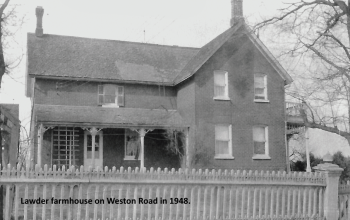
In 1954, at the age of seventeen, Lawder and his pal Ray Devins journeyed to the Thistletown’s Hospital for Sick Children in hopes of meeting beautiful nurses. The trip to the hospital, east of Kipling Avenue and north of Albion Road, proved to be quite worthwhile as they quickly befriended a lovely nurse named Millie Ferguson who agreed to date proposals, first from Devins and then Lawder. In the end, it was the latter’s ruggedness and imaginative storytelling, of such grand things as driving his tractor to school, that won her heart. Millie Ferguson knew that she had found her man, and they were engaged the following year. Assigned to work in Moosonee, Ontario for the winter at the Moose Factory Hospital, Millie would eagerly return in the spring of 1956 to be married. The hospital would continue to be a focal point in their lives.
The hospital’s legacy is really very special. It opened in 1928 as a “country branch” designed specifically for sick children. It replaced the John Ross Robertson - Lakeside Home for Children Facility that was built in 1883 and operated on Centre Island at Hanlan’s Point. The actual site was acquired in 1925 when the provincial government purchased 80 acres of farmland from Francis and Arabella Kingdon. An additional 10 acres of land at the southeast end was then acquired so that vehicles could have direct access from Finch and Islington. This was purchased from Henry and Elizabeth Barker.
A long, circuitous driveway into the hospital was created and lined with fresh new pine trees in hopes that the effervescence would stimulate wellness for the seriously ill children. These trees were part of the 50,000 individual seedlings that were planted on the grounds that year.
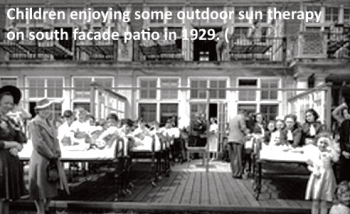
The Thistletown branch of The Hospital for Sick Children was officially opened on October 24th, 1928. John Ross Robertson himself, along with members of the Toronto Automobile Club, picked up 44 children at the Toronto Islands ferry docks and transported them to the new hospital in what they coined a, “celebratory motor parade.” Robertson was a well-known philanthropist and owner of the Toronto Telegram newspaper.
The firm of Sproatt and Ralph designed Georgian classic features with a dramatic main foyer and interior rotunda (with a skylight) and elegant detailing throughout. Having its own steam plant, water tower, filtration system and sewage-disposal, it was also entirely self-sufficient. In the event of a major power failure, electricity could be generated from a separate building that had a steam turbine. The facility had a capacity of 112 children in rooms with six to eight beds. Each room opened onto its own screened verandah so that beds could be wheeled outdoors. Sunshine was encouraged at every opportunity, and the nurturing grounds created a valuable atmosphere.
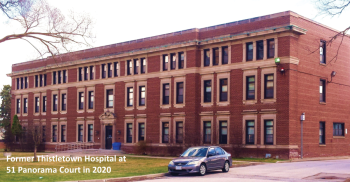
In 1957, the hospital developed into the Thistletown Regional Centre for Children and Adolescents becoming the first residential mental health centre for children and youth in Ontario. However, the first cohort of children destroyed the place, breaking windows, burning mattresses, ripping off doors and attacking the staff. After a period of adjustment, order was brought to the facility so that an era of effective treatment could begin. The next two decades saw an autism research and treatment centre, pool and gymnasium, daycare centre, school and residential buildings added.
As a result of medical advancements, such as vaccinations and antibiotics, the need for a specialized hospital had diminished.
And with the construction of the Panorama Court apartment buildings in 1974, and the extension of Finch Avenue in 1990, the total property was reduced from 90 down to 36 acres. Since 2012, the building remains closed with the entire property earmarked for development.
Those 50,000 seedlings have matured beautifully and are universally enjoyed by those who frequent the public paths that wind throughout them.
Deservingly, the property has been listed with Toronto’s Heritage Registry since May 8, 2014.

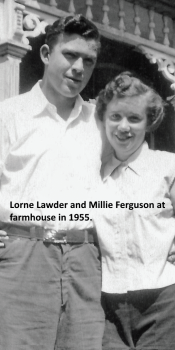
These days, Lorne and Millie Lawder are as happy as ever, and have just celebrated their 64th wedding anniversary on April 21st. The couple have resided in Lindsay, Ontario since 1968 after their Weston Road farm was sold and their access laneway transformed into an industrial road in Emery.
The land where the Lawder farmhouse once stood is now occupied by dozens of factories along Garyray Drive. The building where the couple first met, remains heartlessly idle, awaiting its next incarnation, but the treasure trove of memories from their first encounter there radiates the Lawder home…and Millie Lawder still declares that she still has found her man.














